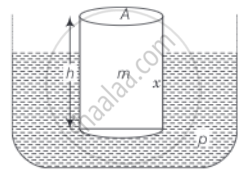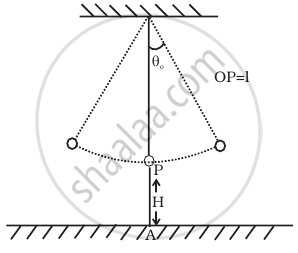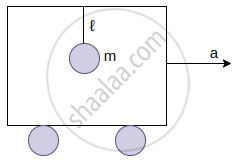Advertisements
Advertisements
Question
A cylindrical log of wood of height h and area of cross-section A floats in water. It is pressed and then released. Show that the log would execute S.H.M. with a time period. `T = 2πsqrt(m/(Apg))` where m is mass of the body and ρ is density of the liquid.
Solution
Consider the diagram,

Let the log be pressed and let the vertical displacement at the equilibrium position be x0.
At equilibrium, mg = buoyant force = (ρAx0)g ......[∵ m = Vρ = (Ax0)ρ]
When it is displaced by a further displacement x, the buoyant force is A(x0 + x)ρg
∴ Net restoring force = Buoyant force – Weight
= A(x0 + x)ρg – mg
= (Aρg)x .....[∵ mg = ρAx0g]
As displacement x is downward and restoring force is upward, We can write
`F_"restoring" = - (Aρg)x`
= `- kx`
Where k = constant = Aρg
So, the motion is S.H.M .....(∵ F ∝ – x)
Now, Acceleration a = `F_"restoring"/m = - k/m x`
Comparing with a = `- ω^2x`
⇒ `ω^2 = k/m`
⇒ `ω = sqrt(k/m)`
⇒ `(2pi)/T = sqrt(k/m)`
⇒ `T = 2pi sqrt(m/k)`
⇒ `T = 2pi sqrt(m/(Aρg))`
APPEARS IN
RELATED QUESTIONS
The period of a conical pendulum in terms of its length (l), semi-vertical angle (θ) and acceleration due to gravity (g) is:
When the length of a simple pendulum is decreased by 20 cm, the period changes by 10%. Find the original length of the pendulum.
let us take the position of mass when the spring is unstretched as x = 0, and the direction from left to right as the positive direction of the x-axis. Give x as a function of time t for the oscillating mass if at the moment we start the stopwatch (t = 0), the mass is
(a) at the mean position,
(b) at the maximum stretched position, and
(c) at the maximum compressed position.
In what way do these functions for SHM differ from each other, in frequency, in amplitude or the initial phase?
A clock regulated by seconds pendulum, keeps correct time. During summer, length of pendulum increases to 1.005 m. How much will the clock gain or loose in one day?
(g = 9.8 m/s2 and π = 3.142)
Show that motion of bob of the pendulum with small amplitude is linear S.H.M. Hence obtain an expression for its period. What are the factors on which its period depends?
When will the motion of a simple pendulum be simple harmonic?
The length of a second’s pendulum on the surface of earth is 1 m. What will be the length of a second’s pendulum on the moon?
A simple pendulum of time period 1s and length l is hung from a fixed support at O, such that the bob is at a distance H vertically above A on the ground (Figure). The amplitude is θ0. The string snaps at θ = θ0/2. Find the time taken by the bob to hit the ground. Also find distance from A where bob hits the ground. Assume θo to be small so that sin θo = θo and cos θo = 1.

A pendulum of mass m and length ℓ is suspended from the ceiling of a trolley which has a constant acceleration a in the horizontal direction as shown in the figure. Work done by the tension is ______.
(In the frame of the trolley)

A particle at the end of a spring executes simple harmonic motion with a period t1, while the corresponding period for another spring is t2. If the period of oscillation with the two springs in series is T, then ______.
